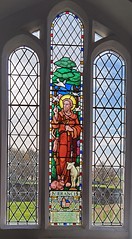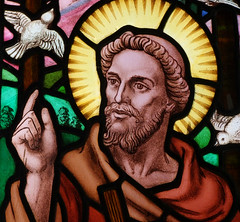| |
|
Heading out under the A14
dual carriageway along Nacton Road can feel like
leaving Ipswich by the back door, for you quickly
escape the commercial and industrial estates and
emerge onto a pleasant country road lined with
oaks, the fields of the Home Farm Estate
sprawling towards woods on both sides. Beyond
Nacton itself the road starts to roll quite
steeply, finally rising to lift you in to the
hilltop village of Levington above the wide
silvery thread of the River Orwell in the valley
below, Felixstowe Docks looming beyond. If the
village name is familiar it may be because it was
given to a variety of compost developed at the
former Fisons Research Centre here. St Peter sits pleasantly grouped
beside the Ship, a fine medieval pub, looking out
over the river. It is a humble little church, its
red brick tower familiar from a number around
here. The tower was under construction by the
1470s, and then in 1487 Margaret Hamond of nearby
Trimley left half a noble to the hanging of
the bells in the steeple, suggesting that it
was complete by then. A date of 1636 on the south
side of the tower remembers the reconstruction of
the bell stage at that time, explaining the 17th
Century feel. The tower was built against a
church which seems likely to have been complete
by the 14th Century, although as Pevsner noted
the windows are pleasingly irregular.
The large red brick buttresses are memorable, and
some of them are fairly recent judging by the
watercolour painted by the Architect Travis
Bickmere which appears at the top of this page.
It was painted on 25th July 1915, and was lent me
by his grandson Chris. The buttresses that hold
up the east wall had not yet been built, and
there seems also to have been some changes to the
south wall.Perhaps they were part of a general
restoration, because there also appear to be some
holes in the roof in the painting.
The attractive timbered
south porch has been converted into a vestry, and
so unusually for Suffolk you enter the church
through the west doorway beneath the tower. You
step into an unbroken line of nave and chancel
that is small and simple, white-walled under an
old barrel-vaulted roof. At some point metal ties
have been put in to stop the walls spreading.
Brick floors enhance the simplicity, and there
are red brick outlines to the windows. The font
appears to be of the late 15th Century and
probably came at about the same time as the
tower. Its 17th Century font cover of silvered
oak is attractive. The pulpit is contemporary
with the font cover and the rustic 19th Century
benches against it look towards a sanctuary which
is faced with 17th Century wood panelling, said
to have been brought here from nearby Brightwell
Hall.
Glass of the 1950s
depicting St Francis above an un-East Anglian
looking church is set in one of the windows on
the south side. The glass is unsigned, although I
wonder if it might be by Powell & Sons. It
remembers members of the Woolnough family,
Frederick and Clara dying in 1938 and 1946
respectively, their daughter Clara dying in 1952.
The other two mentioned are their sons George and
Alan, and although the window does not give the
date, George was killed on the Western Front in
1917 and appears nearby on the Levington war
memorial.
  
At the time of the 1901
census the Woolnoughs were living at Levington
Post Office where Frederick was recorded as a shepherd.
With them were their ten year old daughter Clara
and sixteen year old son George, whose occupation
was given as gamekeeper's help. They
were still at the Post Office in 1911 when Clara
was recorded as the sub-post mistress,
Frederick's occupation still given as shepherd.
Their twenty year old daughter Clara was living
at home still. However, one of the questions
asked in 1911 was how many children had been born
to the marriage, and how many had died, and
Frederick declared that they had had three
children, two of which were still alive. We know
that Clara and George died after 1911, and as
Frederick and his wife Clara were both already
about fifty years old by then it seems certain
that Alan was the child who had died. The birth
of an Allan Frederick Woolnough was recorded in
the Woodbridge Registration District in the first
quarter of 1887, and the death of a child with
the same name in the same registration district
in the fourth quarter of the same year. It seems
likely that this was Frederick and Clara's son.
The rood beam survives
above, the only mark of the division between nave
and chancel. Mortlock says that it was revealed
when a low ceiling was removed in 1920, and it is
easy to imagine that there was once a tympanum
set in the space above it. It is carved on the
front with a leafy scroll effect, and the carving
at least probably dates from 1524 when one Thomas
Hill made a bequest to the reparation of the
rood loft. In the east window hangs a
roundel depicting the head of Christ in Majesty
which appears to incorporate some medieval
fragments.
At the time of the Census
of Religious Worship in 1851 the population of
Levington parish was almost two hundred and
fifty, but the average attendance on a Sunday
morning was just thirty, and even that is likely
to have been talked up. The benefice was
consolidated with that of neighbouring Nacton,
and Harry Edgell, the Rector of Nacton who filled
in the return for Levington, excused the low
attendance by claiming that a few scholars
attended Nacton church. Perhaps realising
this wasn't in itself sufficient to explain the
low numbers, he went on to note that there were many
Baptists and Independents in the parish, and
even worse than that there was a Dissenting
Sunday School. His own parish of Nacton with
its population of nearly six hundred fared no
better, for the Sunday morning attendance was
only fifty, not including the sixty-odd scholars
who had to be there.
Although there was no
non-conformist chapel in Levington itself there
were three within easy walking distance. The
Independent Chapel in Nacton was an outstation of
the famed Tacket Street Meeting in Ipswich, and
it attracted roughly the same number as the
parish church. The Nacton Baptist Chapel and the
Trimley St Martin Wesleyan Chapel, also close by,
attracted one hundred and thirty people between
them, but even then, when you add all these
numbers up they don't amount to much compared
with the total populations of the three parishes.
Perhaps people in Levington and Nacton simply
didn't go to church, although the 19th Century
Anglican revival was slow to reach these coastal
parts of East Anglia, and that would change.
|
|
|

